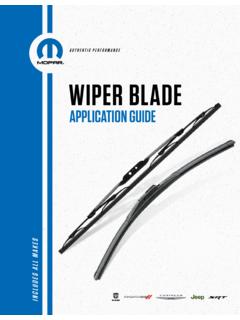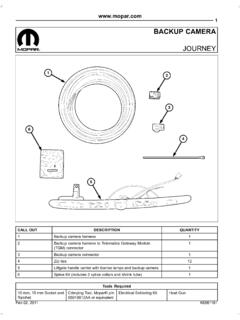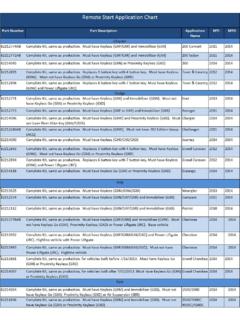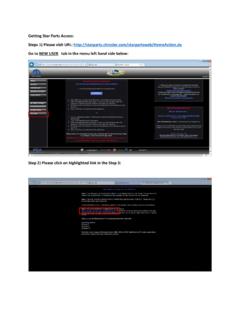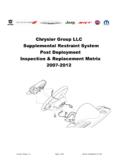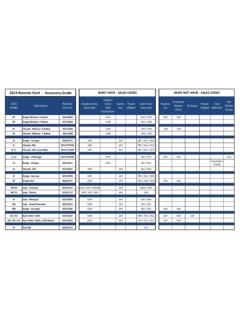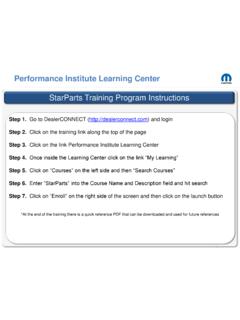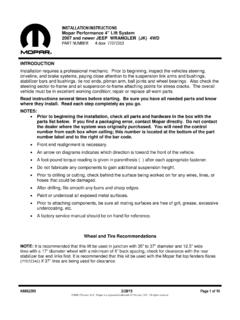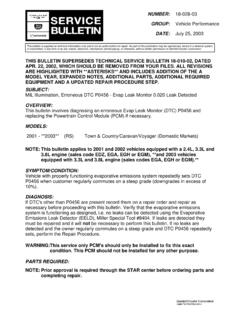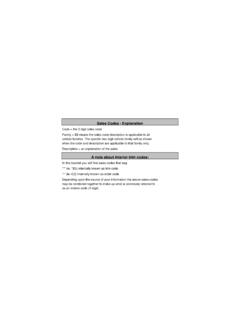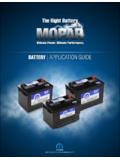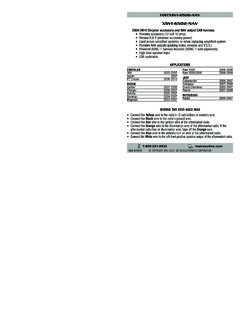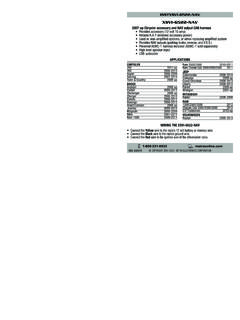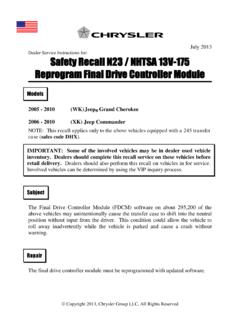Transcription of SEAT BELT INSTALLATION SHEET K6855933
1 1 June 22, 2016 Lap/Shoulder Belt Operating Instructions Enter the vehicle and close the door. Sit back and adjust the seat. The seat belt latch plate is above the back of the front seat, and next to your arm in the rear seat (for vehicles equipped with a rear seat). Grasp the latch plate and pull out the seat belt. Slide the latch plate up the webbing as far as necessary to allow the seat belt to go around your lap. When the seat belt is long enough to fit, insert the latch plate into the buckle until you hear a click.
2 Position the lap belt so that it is snug and lies low across your hips, below your abdomen. To remove slack in the lap belt portion, pull up on the shoulder belt. To loosen the lap belt if it is too tight, tilt the latch plate and pull on the lap belt. A snug seat belt reduces the risk of sliding under the seat belt in a collision. Position the shoulder belt across the shoulder and chest with minimal, if any slack so that it is comfortable and not resting on your neck. The retractor will withdraw any slack in the shoulder belt. To release the seat belt, push the red button on the buckle. The seat belt will automatically retract to its stowed position.
3 If necessary, slide the latch plate down the webbing to allow the seat belt to retract fully. If a seat belt is not long enough to fit properly, even when the webbing is fully extended and the adjustable upper shoulder belt anchorage (if equipped) is in its lowest position, your authorized dealer can provide you with a Seat Belt Extender. The Seat Belt Extender should be used only if the existing seat belt is not long enough. When the Seat Belt Extender is not required for a different occupant, it must be removed. WARNING! ONLY use a Seat Belt Extender if it is physically required in order to properly fit the original seat belt system.
4 DO NOT USE the Seat Belt Extender if, when worn, the distance between the front edge of the Seat Belt Extender buckle and the center of the occupant s body is LESS than 6 inches. Using a Seat Belt Extender when not needed can increase the risk of serious injury or death in a collision. Only use the Seat Belt Extender when the lap belt is not long enough and only use in the recommended seating positions. Remove and store the Seat Belt Extender when not needed. Seat Belts And Pregnant Women Seat belts must be worn by all occupants including pregnant women: the risk of injury in the event of an accident is reduced for the mother and the unborn child if they are wearing a seat belt.
5 Position the lap belt snug and low below the abdomen and across the strong bones of the hips. Place the shoulder belt across the chest and away from the neck. Never place the shoulder belt behind the back or under the arm. WARNING: To avoid serious or fatal injury on vehicles equipped with airbags, disable the Supplemental Restraint System (SRS) before attempting any steering wheel, steering column, airbag, Occupant Classification System (OCS), seat belt tensioner, impact sensor or instrument panel component diagnosis or service. Disconnect and isolate the battery negative (ground) cable, then wait two minutes for the system capacitor to discharge before performing further diagnosis or service.
6 This is the only sure way to disable the SRS. Failure to follow these instructions may result in accidental airbag deployment. WARNING: To avoid serious or fatal injury during and following any seat belt or child restraint anchor service, carefully inspect all seat belts, buckles, mounting hardware, retractors, tether straps, and anchors for proper INSTALLATION , operation, or damage. Replace any belt that is cut, frayed, or torn. Straighten any belt that is twisted. Tighten any loose fasteners. Replace any belt that has a damaged or ineffective buckle or retractor. Replace any belt that has a bent or damaged latch plate or anchor plate.
7 Replace any child restraint anchor or the unit to which the anchor is integral that has been bent or damaged. Never attempt to repair a seat belt or child restraint component. Always replace damaged or ineffective seat belt SEAT BELT INSTALLATION SHEET K6855933 FOR USE IN RAM D- SERIES TRUCKS (D_) VEHICLES 2 June 22, 2016 and child restraint components with the correct, new and unused replacement parts listed in the chrysler Mopar Parts Catalog.
8 Failure to follow these instructions may result in possible serious or fatal injury. WARNING: To avoid serious or fatal injury on vehicles equipped with the Occupant Classification System (OCS), do not modify the front passenger seat assembly or center floor console in any way. Do not use any prior year, subsequent year, secondary or aftermarket seat trim covers. At no time should any Supplemental Restraint System (SRS) or OCS component be modified or replaced with any part except those which are specified for the particular vehicle application in the chrysler Mopar Parts Catalog. Failure to observe these precautions could cause an OCS miscalibration condition, which may result in the passenger airbag failing to deploy when required or deploying when not required.
9 WARNING: To avoid serious or fatal injury, never strike or drop a seat weight sensor or the passenger side front seat assembly to which the sensors are secured as it can damage the sensors or affect their calibration. The seat weight sensors and the passenger side front seat assembly must be handled with care to avoid damage to the sensors. Do not sit upon or place any loads upon a passenger side front seat while it is removed from its mounts in or outside of the vehicle. If an individual sensor is dropped or damaged, replace the sensor with a new and unused unit. If a seat has been dropped during removal or loaded while removed from its mounts, replace each of the seat weight sensors with new and unused units.
10 Failure to observe this warning could result in an accidental, incomplete, or improper passenger side front Supplemental Restraint System (SRS) component deployment. WARNING: To avoid serious or fatal injury on vehicles equipped with the Occupant Classification System (OCS), any time the passenger side front seat assembly has been removed or loosened from the vehicle for service of any vehicle component or system the Occupant Classification System (OCS) Verification Test must be performed using a diagnostic scan tool and the Occupant Classification Seat Weight special tool following reinstallation. Refer to the appropriate diagnostic procedures.
